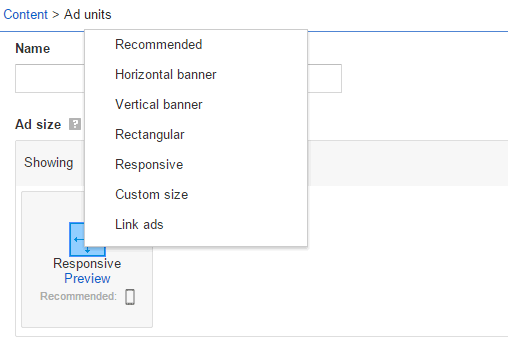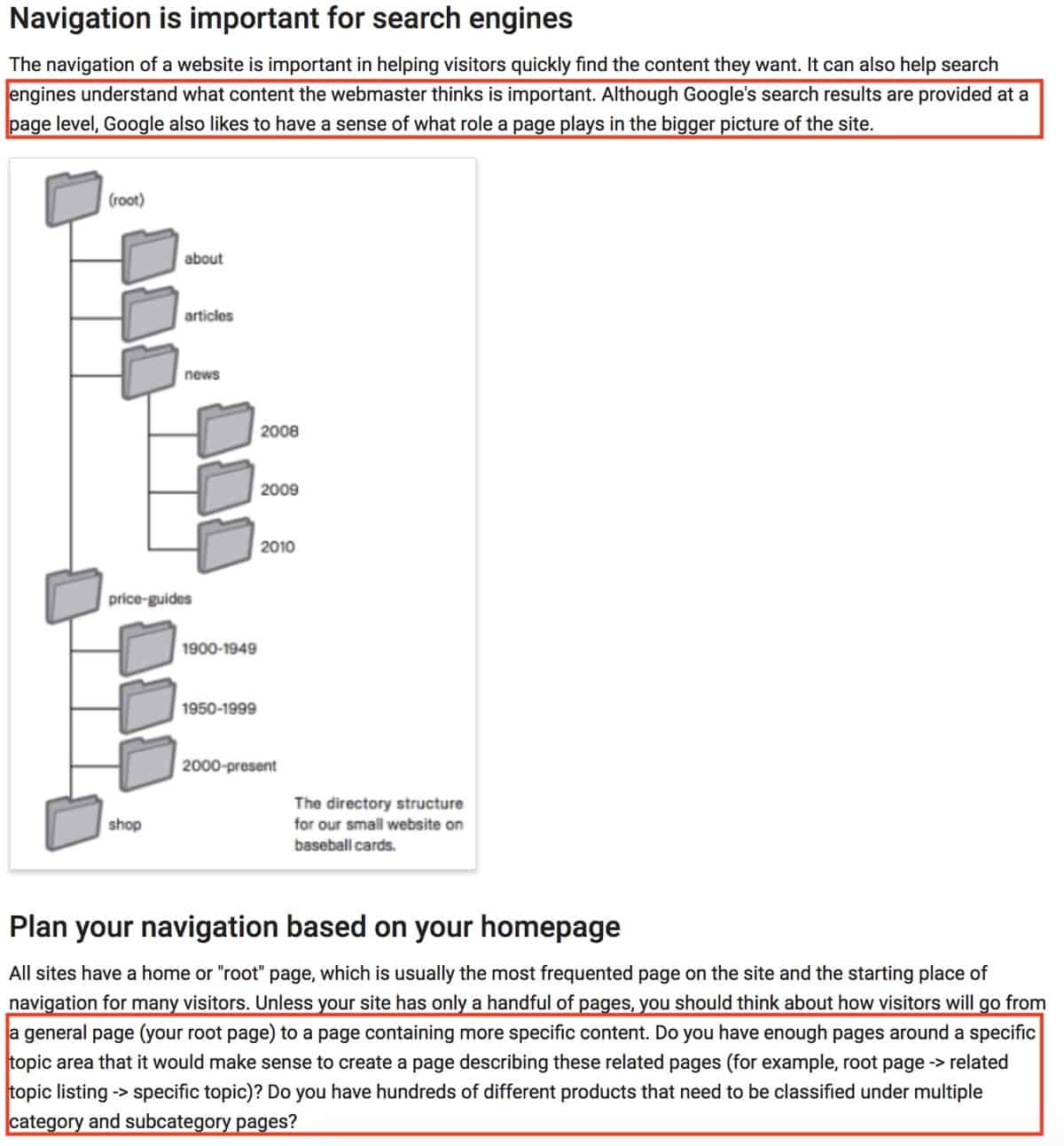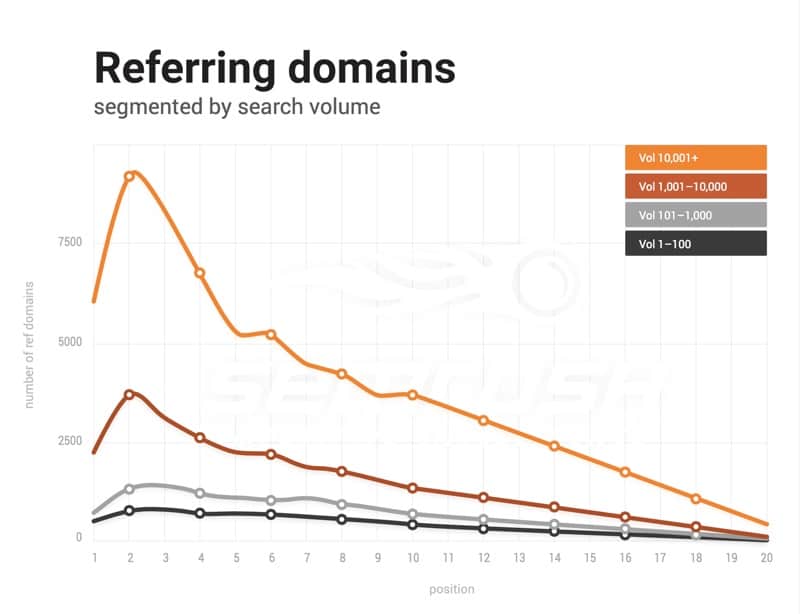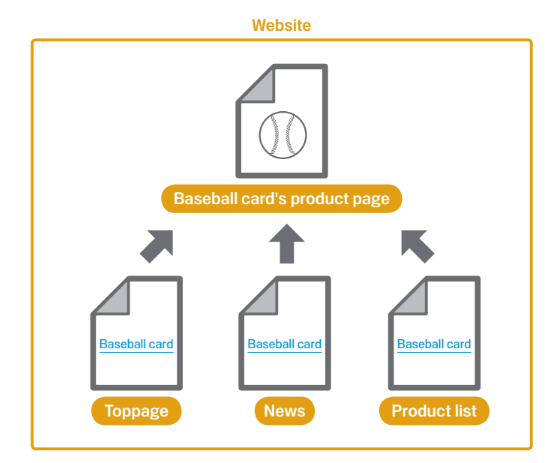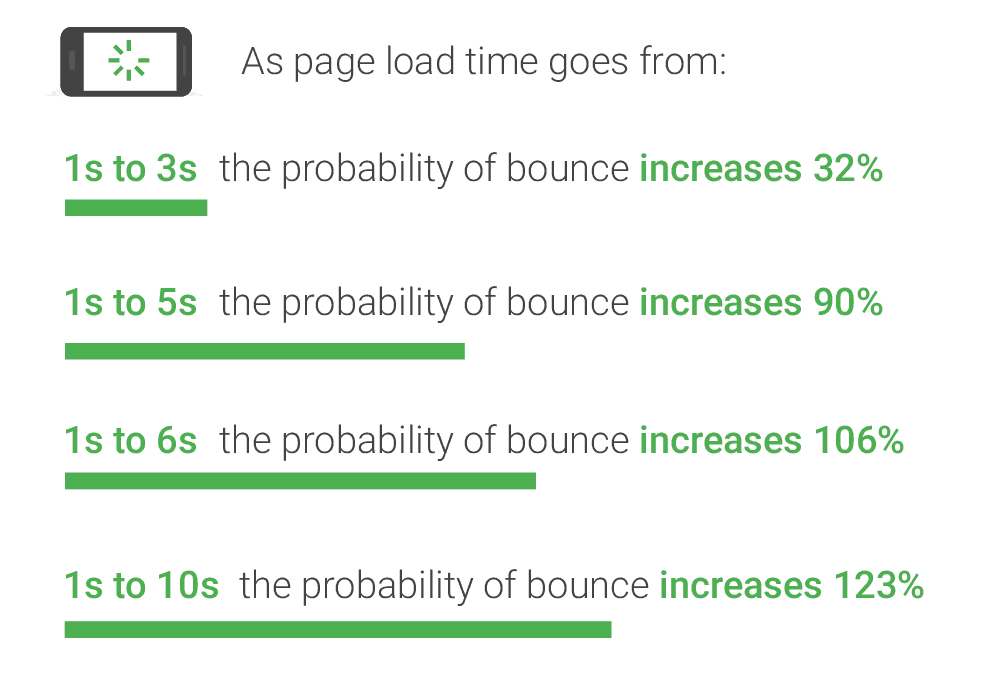To increase your blog traffic to over 400,000 thousands visits per month you need more than just good SEO. You need a solid plan and a strategy that will differentiate your blog from the rest. It’s not easy to do but it’s not impossible either. During the process, I have learned a lot of things and I hope that this post will help you understand how to do the same and grow your blog traffic to these numbers.
Let’s take it from the beginning, the blog is Calorie Secrets. It is a weight loss / fitness /nutrition blog in an industry that is considered to be a ‘million dollar industry’. Thousands of people per day are searching the web for advice on how to maintain their diet, lose weight or switch to a healthier lifestyle.
[Tweet “How to increase blog traffic to 400K visitors per month #SEO”]
The fact that ‘dieting’ is a popular subject automatically means that the competition is huge and this makes it even more difficult to create a blog to compete with the rest. If you also take into account that dieting is a topic that is covered in detail by online newspapers and magazines this makes things even more difficult.
How it all started
Before launching Calorie Secrets in 2012, I had more than 5 years working experience in the weight loss field as a blogger. I developed a number of websites, wrote hundreds of articles, knew who were the main players in the field and had a good knowledge of the industry from an SEO perspective.
I was monitoring rankings for several keywords on a daily basis and I could see websites come to the surface or disappear every time Google was making a change to their ranking algorithms (and this was even before Panda and Penguin).
All this information and knowledge helped me a lot in creating a solid plan for Calorie Secrets which turned out to be a successful one that got the traffic of the blog to over 400K visits per month, three years later.
The numbers you want to see
Before explaining how I created the blog, what things I considered important and how the traffic grew to these levels, let me show you some data that will make this post more interesting.
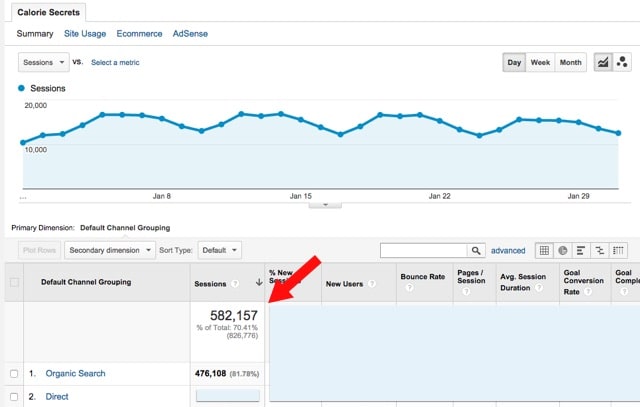
The screenshot above shows the total traffic for January 2015. As you can see the organic search was 476 thousands and the rest comes from direct visits, email, social and referrals. Traffic in the diet field is seasonal, it goes up between January until August and then drops to lower levels in September until the end of the year.
Keep reading to see how long it took the traffic to reach the 400K milestone.
The Calorie Secrets Story
Picking up a domain name
When starting a new blog the first thing that you need to do is pick up a domain name. Back in 2012, it was debatable whether keyword rich domains had a ranking advantage (today it is clear that they don’t). Nevertheless my aim was to get a domain that is maximum 2 words, easy to remember and descriptive about the content of the website.
I was not willing to pay extra to get a premium .com domain so I went for the .net version. I did have experience with .net domains before so I knew in advance that this wouldn’t have any negative effect on my efforts to rank this website in Google.
Choosing a blogging platform
This was an easy decision, the best blogging platform is WordPress and never thought of choosing something else. When it comes to theming I wanted something simple and flexible and at that time Thesis was among the most popular themes so I spend $50 (if I remember correctly) purchasing it. This was the first money I had to spend on the website.
Creating the blog
I didn’t spend a lot of time creating the website. Thesis had a lot of configuration options and I also had programming experience to make some customizations I needed and everything was good to go in a couple of days.
My idea was to keep the blog structure simple with 4 basic categories together with the rest of the pages that are essential like the about us, contact us, sitemap and privacy policy.
I did some changes to the homepage though to showcase 5 sticky posts together with a list of the latest articles. It’s a good practice to keep your most important content on your homepage or sidebar because it helps in a number of ways. I am using the same practice on this blog, look for the ‘Must Read’ section on the right sidebar.
Creating a content plan
So far that was the easy part of the process. Once you register a domain name, pick up a nice theme and setup your blog things get tougher because it’s the time to think about the content. Empirically this is the point that many bloggers quit because it’s easier to say ‘I will create a blog and write content on it’ than actually doing it.
There are a lot of challenges to overcome and a lot of questions to answer. What should I write about, how to write it, how to make the content interesting, how long to make my posts, how often to publish new content; questions that are important for the success of your blog in the long term.
What should I write about? The weight loss / dieting in an endless topic. There are so many things to write about which are related to the field and this can make your life difficult in the beginning.
As I mentioned above, I had experience in the niche so pretty much I knew what my focus would be, that’s why I have chosen the categories ‘weight loss tips’, ‘diet tips’, ‘fitness advice’ and ‘how to’.
People searching to lose weight or become fit, in the majority, they have questions and they need answers, tips and step by step instructions on how to achieve their goals.
Two important decisions I took at that time, which are still relevant today more than ever, for any type of blog, were:
First to provide for evergreen content and second to target low competition, long tail keywords.
Evergreen content is simply content that is relevant for a long period of time. People looking to lose weight in 2012 had the same questions as people in 2015 and probably this will be the same for many years to come. So, my intention was to find topics that would be relevant for many years and not topics that were news or trending for a limited period.
When I did my keyword research to come up with the actual titles, my aim was to find search phrases that were long tail keywords (i.e. more than 2 words) and low competition. Luckily enough, the nature of the weight loss industry allows you to find a lot of search queries that meet the above guidelines.
People tend to use more words when looking for information about dieting because most probably they already did the typical searches i.e ‘weight loss’, ‘diet’, ‘fitness’ and they did not find a specific answer to their question so they use more words to come up with a more precise search.
For example you will find phrases like “how to lose 5 pounds in a week’ or ‘weight loss tips for women over 40’ that are perfect to be used as exact match post titles.
How to write it? If you have good knowledge about a topic and can devote the time needed you can write the content, if not then you need to find other ways. In my case I wrote hundreds of articles about related topics in the past so at the beginning I decided to write the posts myself.
The problem is that besides being interested in fitness & healthy lifestyle I was not a real expert, meaning I did not have the qualifications or the academic background to back up my articles with real data. I didn’t like the idea of building a diet blog based on my enthusiasm about the topics but I wanted to raise the bar and only publish content written by real experts who could prove their expertise.
It was also that time that Google started taking into account the ‘authority of content’ and introduced Google+ authorship (which is no longer used) as a way to make the web less anonymous.
So, I took the risk of hiring professionals to write the content for the blog. Each and every blog post published since then it is written by certified professionals and it is also backed up by research studies and real data.
In my opinion this contributed a lot to the success of the blog because it is important to know that when you read something that has to do with health advice is not just written by someone who is a fanatic about the topic but by professionals who have studied about it and can guarantee that the information provided is accurate and scientifically proven.
I know that some people may disagree about this approach but this is how I decided to differentiate my blog’s content from the majority of the fitness sites you will find on the web.
The risk taken related to content was to find good writers and pay them, waiting that at some point the blog will generate enough traffic and money to get your money back and start making a profit.
How long should the blog posts be? I will expand further about this in a new article, but for Calorie Secrets I decided that the minimum word length of any post published on the site would be 800 words. There was no maximum limit, and all my posts adhere to this rule.
How often to publish new content? Frequent publishing has many advantages especially for topics related to healthy lifestyle and dieting so I have set the publishing frequency to be 3 times per week (Mon, Wed, Friday), a schedule that I use until today.
How to increase your blog traffic
Once you sort out the content part, the next step is to start thinking of ways to increase your blog traffic and preferably your organic traffic which is the most valuable type of traffic.
I know that if you are still reading this post, this is the part you want to read the most so I will try and give you as much details as I can.
Before the go live
Before start publishing content on a new blog, I always prefer to have 4-5 posts ready in advance in draft mode and then publish them one per day to get the ball rolling. There is no real SEO advantage or benefit from doing this, it’s just my way to start a new website. It’s good to give an indication to the search engine bots from the beginning that the site will be updated frequently but other than that there is not much to it.
Keeping a schedule
What is important after you go live is to keep a constant publishing schedule. I made sure that once the blog was live, it was updated 3 times per week with good quality and unique content.
Webmaster tools, Analytics and Rankings
As soon as I published the first posts, I have registered the site with Google and Bing webmaster tools, submitted the sitemap and added analytics. This helped me a lot in monitoring the performance of the blog, improvement in rankings and increase in traffic.
I also registered with SerpBook, the tool I use to keep track of the ranking position of different keywords in Google and Bing. This is very helpful and necessary because it helps you see how your ranking positions are improving over time.
As you will read below, you won’t get to the first page of Google immediately so its good to know your progress. After I registered with SerpBook, I have created a list of keywords from both my keyword research and also from Google Webmaster tools (search analytics report under search traffic).
First organic visitor
It took a couple of months do get the first organic visit from Google. At that time the blog had already 10+ published posts and I was glad to see that I started gaining rankings in the 3rd and 4th pages of Google. While that didn’t bring any real traffic yet, it was a very encouraging signal.
Free tools and repeating visitors
If you read the ‘About’ page you will see that the philosophy of the blog from the very beginning was to provide useful information but also free tools people can use to achieve their fitness goals.
I always believed that besides the content, you need to give more reasons for people to come back and for that purpose I have developed a free calorie counter, different calculators and diet plans you can download or use for free.
This method worked pretty well as I started noticing in analytics an increase in the number of repeating visits.
Android, Chrome and Amazon
In parallel to publishing new content on a weekly basis, I also created an android app and published it to the Google play store (downloaded more than 250,000 times until today), a Chrome app and published it to the Chrome store (has more than 20,000 active users) and an amazon app for the Amazon app store.
It did cost me some money to develop those apps but they really helped a lot in spreading the word and they also contributed in the increase of direct and repeating visits.
Newsletter
In addition to the above, I also started a newsletter that has now more than 30,000 members that generates a good amount of traffic every time I send out a newsletter.
Social Promotion
As soon as the blog had a decent number of posts, I started social media campaigns in Google+, Facebook, Twitter and Pinterest. In Google+ I already had a good presence so the posts started gaining a decent number of +1s and shares and on Facebook I used facebook ads to increase the page likes. A tactic that I am still using today and that’s why the blog fan page has close to 100,000 followers.
For pinterest I created a business page and update it every time I publish a post and for twitter although I do have an account, I am not actively using it. Pinterest does create a few thousands of visits per month but for sure it is a channel that I am not using to its full potential.
I also created an instagram account but only used it for a couple of weeks.
Despite the fact that social traffic today is much less than organic traffic, it contributed a lot (and it still does) in getting more natural links from other websites and blogs.
Adwords
In the beginning and once the blog was 4 months old (and before adding any ads on it), I also used adwords to get direct visits from Google. It cost me to run the campaigns but it was another opportunity to promote the content, get more subscribers, get more users for the tools and increase the number of repeating visitors.
Blog Commenting
When the traffic gradually increased to a few thousands per month I also started receiving comments for the posts. I decided to have a very strict comment policy (I still do) because I wanted to avoid spam or comments that added no value to the content.
I didn’t approve any comments that included links or that were made for the purpose of getting a link or added no real value to the page. This may have helped in the long run because I never had to delete content from a page because it was spam or not related to the post.
Advertising and monetization
My initial goal when starting Calorie Secrets was not monetization. I first wanted to get a decent amount of traffic and then add ads to it. Most fitness blogs were full of ads (at that time) and did not want to create another made for adsense website.
I believed that if you showed respect to the users by not making a site full of ads they would come back again and again. I also decided not to use any affiliate programs and get into the mode of trying to convince people to buy a particular product or diet plan, my idea was to give them the facts and stay unbiased.
I added adsense when the blog was 8 or 9 months old but my ad positions are not aggressive or in any way violating adsense guidelines or the user experience. I do make a decent amount from adsense and I most probably stick with adsense in the long term.
Mobile friendly
Long before Google decided to promote mobile friendly websites, I noticed that the mobile searches were increasing more than the desktop thus contributing to a large part of traffic and income. Although my website theme was not responsive, I created a responsive version and that contributed to a further increase in the organic traffic coming from mobile.
Link Building or lack of it
I deliberately did not discuss about link building yet because this is not a practice I followed for Calorie Secrets. It may sound strange but that’s the case. I started the blog right after the release of Panda 3.5 and Penguin and the last thing I wanted was to get a Google penalty.
That’s why I decided to concentrate more on the content, tools and apps (as described above) and less or almost nothing on building links. I did do a couple of guest posts in high quality websites but that’s about it.
The blog has a decent amount of incoming links which is the result of natural links created by other bloggers and websites in the niche and this is something that definitely played a big role in the traffic increase (especially the organic traffic).
Social promotion was a great way to put the content in front of other bloggers and as the rankings became better more natural links were created because of the quality of content.
I am glad that I followed this route because I never feared that I would lose traffic after a Google update.
Health on the web
Health on the net foundation is a non-profit organization that verifies the trust and validity of health websites. If you see on the sidebar of Calorie Secrets there is a badge you can verify the HON certificate. Being certified for HON is important for health related websites since it is an indication to the reader that what they read is reliable and trustworthy. There is a process to get certified that takes a lot of time but I consider this to be very important if you want to create an authority website or blog.
Organic traffic grows to 100K, 200K, 300K, 400K visits per month
A lot of people ask me how long it took for the traffic to grow and since this is interesting and helpful information to know, I will outline some numbers below.
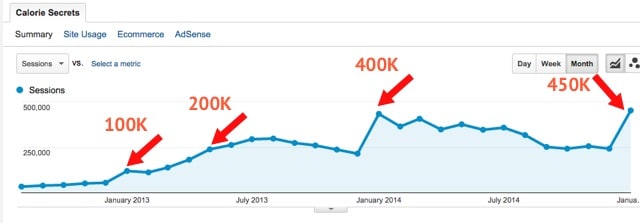
Organic traffic (mainly US traffic from Google), reached the 100,000 thousand visits per month as soon as the website was 12 months old. At that time I had 184 published posts.
Four months later (blog was 1.5 years old) organic traffic doubled to 200,000 with 237 published posts.
It reached the 300,000 milestone after 2 years with 333 published posts and it passed the 400,000 thousands visits (organic, direct and referral) in 2015 with close to 500 posts.
Lessons learned that you can use in your blogging journey
From what you read above (if you are still reading), it is obvious that the success was not due to extraordinary SEO tricks or to excessive link building but to the other factors that helped the site kick off fast and grow steadily.
If I had to summarize the lessons learned from working on this website, these are the main points:
#1 – Don’t start a website in a niche you don’t know well – before even starting, get to know as much as you can about the niche. Find out the leaders, do your keyword research, take note of what kind of content they publish, how often etc.
#2 – Make sure that you can provide good content for the topics you choose – if you are not an expert, either become one of hire people that are experts.
#3 – Be prepared to spend some money on the site – Maybe you have to hire writers, do some adwords or Facebook, buy a theme or plugins; consider this as the initial investment that will pay off later.
#4 – Respect your users and give them incentives – Don’t create a website full of ads or affiliate links. You not only risk in getting penalised by Google but you also drive repeating visitors away. Try to find some free tools or books to give them and keep them coming back.
#5 – Don’t forget the newsletter – Email marketing still works and one of your main objectives is to grow your email list.
#6 – Look for other promotion methods besides SEO – SEO is a must but other methods work good and they indirectly help SEO.
#7 – Go Social early – Social media promotion is the best way these days to get more visits and attention until organic traffic flows in. Use it wisely avoiding spammy techniques and practices.
#8 – Never violate or think of violating any Google Guidelines – You may read promising posts from people making tests on how to get top positions or stuff like that – stay away from anything that may be considered as a rule violation. Stick to the guidelines and aim for long term success than a short term burst and then failure.
#9 – Mobile is a must – Make sure that your website is mobile friendly from day one and that if you use ads on the mobile friendly version these are not violating any guidelines (for example you are not allowed to have a 300×250 ad above the main content on a mobile page).
#10 – Go slow on building links or don’t do it at all – It may be ok to build a couple of links in the beginning but do it only from trusted websites and only if the links matter. Avoid creating links from low quality websites. It’s not a matter of quantity any more but quality.
#11 – Be patient – It takes time for SEO to work, don’t get disappointed if you don’t get any results in the first months, keep doing your work and results will come.
#12 – Be consistent – Try to keep to a publishing schedule. This is good for SEO but also for direct visits.
#13 – Engage with your readers – Reply to comments but don’t publish comments that don’t make sense or look spammy.
#14 – Don’t spend too much time on the design – Do create a nice, simple, fast and functional website but no need to spend hundreds of dollars in design or themeing.
That’s about it, that’s how I created a successful blog and that’s how you can do the same. If are somehow lost and don’t know what you are doing wrong, there is always the opportunity to get professional help at an affordable cost. Check out my seo audit service or find other people in the field who have the experience to get you into the right direction.
I hope you found this post interesting and informational, if you have any questions let me know in the comments and will do my best to answer them. Don’t forget to share this post if it was something that you liked.
